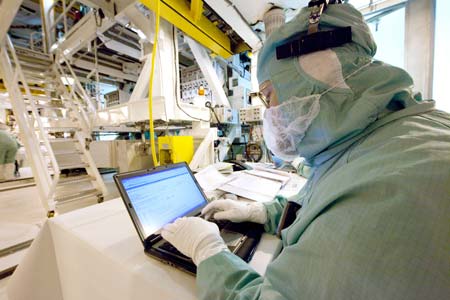KENNEDY SPACE CENTER, Fla., May 08, 2009 -- A Boeing [NYSE: BA] team in Florida has ensured that all necessary interfaces, data systems, and hardware are ready for Space Shuttle Atlantis' mission to the Hubble Space Telescope. When Atlantis launches May 11 on mission STS-125, its payload will include the materials needed to upgrade and repair the Hubble for the fifth and final time.
During five spacewalks over 11 days, the repair crew will install two new science instruments, six new gyroscopes and six new batteries. They also will replace or repair two failed science instruments. The repair work will keep the telescope functioning until at least 2014.
Boeing serves as primary payload integrator for the shuttle under its Checkout, Assembly and Payload Processing Services (CAPPS) contract at Kennedy Space Center. Under the contract, Boeing integrated the four carriers into the shuttle that contain all of the hardware and tools for the Hubble mission. Boeing teams are responsible for transporting the carriers to the launch pad, maintaining them there, and helps to install them in the shuttle's school-bus-sized payload compartment for launch. The carriers each provide multiple power and data hookups -- all tested and verified by Boeing personnel. The astronauts will use the carriers when they pull the Hubble into the shuttle's payload bay for repair in space.
"It has been a great team effort between NASA, Hubble, Boeing, United Space Alliance and industry to ensure this high-profile mission goes smoothly," said Mark Jager, CAPPS program manager for Boeing. "Payload processing for Hubble missions presents challenges beyond those of other shuttle missions. It has taken years of preparation and detailed verification tests to make sure everything is ready for launch."
The Boeing team provides engineering analysis and support for the complex payload. One of the first tasks they perform is to plan for the purge, electrical, mechanical and data interfaces between the shuttle and the Hubble payload. These orbiter connections keep Hubble "alive" while astronauts switch out and upgrade various components of the telescope.
"Those electrical and data lines have to be verified for communications downlinks, software and telemetry commands," said Ed Baglioni, Hubble Space Telescope flow manager for Boeing. "Once the Hubble is mated to Atlantis, all transmissions between the telescope and the ground will go through the shuttle."
On the launch pad, the Boeing team works with shuttle operations contractor United Space Alliance to maintain a positive airflow balance, or purge, that protects the sensitive Hubble instruments from potential contamination.
A unit of The Boeing Company, Boeing Integrated Defense Systems is one of the world's largest space and defense businesses specializing in innovative and capabilities-driven customer solutions, and the world's largest and most versatile manufacturer of military aircraft. Headquartered in St. Louis, Boeing Integrated Defense Systems is a $32 billion business with 70,000 employees worldwide.
###
Contact:
Susan Wells
Boeing Space Exploration
321-446-4970
susan.h.wells@boeing.com
Ed Memi
Boeing Space Exploration
281-226-4029
edmund.g.memi@boeing.com
 USA
USA


